The epitaphs staged on exhibition are valuable and interesting historical items of the old Pomeranian art associated with more than 450 years of Protestantism in Pomerania. They come from churches located in the area of today’s Central and Western Pomerania. Deposited in the Pomeranian Dukes’ Castle in Szczecin, they are now held as part of the collection of the Museum of Central Pomerania in Słupsk. The objects in commemoration of the dead may be a basis for studying customs and traditions of the former inhabitants of these lands. They also testify to the richness of the Christian culture and craftsmanship of Pomeranian artisans.
It was in antiquity that epitaphs were first used to commemorate the dead. Originally, an epitaph was a table on which sentences and information about a dead person were carved. They were placed on graves or in burial rooms. In the Middle Ages almost all cities and villages in Christian Europe had churchyards. The clergy, important people, benefactors to the Church and their children were designated to have their burial places in church crypts. To commemorate people who were buried there, epitaphs were hung on the walls. Some of them were very simple and contained only the name, surname and age of a dead person. But some were monumental sculptural compositions including not only the most important details about the dead but also their achievements and merits, portraits and heraldic histories of the family, as well as a rich theological and allegorical content depicted by means of sculptures and paintings.
After the Middle Ages, they reappeared in the 15th and 16th centuries. They were made of wood, stone and metal. With each subsequent decade, they were more and more impressive. Apart from the table itself they contained portraits of the dead, coats of arms, sculptures and paintings blending together to form theological or allegorical programmes. The development of epitaphs was at its height in the 18th century, i.e. in the Baroque period. At that time, a funeral and all related celebrations often lasted for weeks. The church was decorated for the occasion: the catafalque staged a sarcophagus or coffin ornamented with fittings, and services were adorned with dedicated musical settings and funeral speeches. Furthermore, it was followed by a consolation feast, i.e. a funeral feast which lasted for at least several days.
The Pomeranian epitaphs were mainly created in Protestant circles. It was in the early 20s of the 16th century that Luther’s ideas reached these areas, and after a diet had assembled in Trzebiatów in 1534, they became part of the Pomeranian history for four hundred years. After World War II, when a significant part of Pomerania became part of Poland, another transformation took place. This time, the majority of the population displaced to Pomerania (from Szczecin to Gdańsk) was Catholic. The conversion to Evangelical-Augsburg faith in Pomerania was associated with changes in the language of art. The abandonment of the veneration of saints influenced the propagation of allegorical motifs in which information was carried by personifications of virtues and ancient gods illustrating abstract concepts such as time, heroism, and piety.
Until World War II, most Pomeranian churches were full of objects collected in memory of the dead. The war damage and its aftermath decimated that legacy significantly. Only few of them have survived to this day, and most of them are museums’ collections.
The Pomeranian epitaphs were mainly created in Protestant circles. It was in the early 20s of the 16th century that Luther’s ideas reached these areas, and after a diet had assembled in Trzebiatów in 1534, they became part of the Pomeranian history for four hundred years. After World War II, when a significant part of Pomerania became part of Poland, another transformation took place. This time, the majority of the population displaced to Pomerania (from Szczecin to Gdańsk) was Catholic. The conversion to Evangelical-Augsburg faith in Pomerania was associated with changes in the language of art. The abandonment of the veneration of saints influenced the propagation of allegorical motifs in which information was carried by personifications of virtues and ancient gods illustrating abstract concepts such as time, heroism, and piety.
Until World War II, most Pomeranian churches were full of objects collected in memory of the dead. The war damage and its aftermath decimated that legacy significantly. Only few of them have survived to this day, and most of them are museums’ collections.





